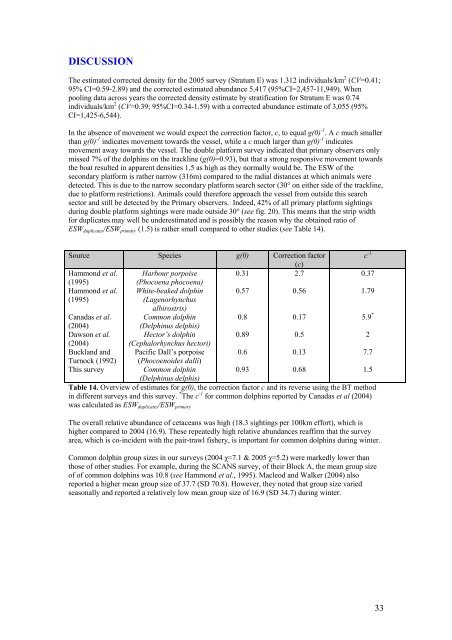Report of a cetacean survey in the Western Approaches of the ...
Report of a cetacean survey in the Western Approaches of the ...
Report of a cetacean survey in the Western Approaches of the ...
You also want an ePaper? Increase the reach of your titles
YUMPU automatically turns print PDFs into web optimized ePapers that Google loves.
DISCUSSIONThe estimated corrected density for <strong>the</strong> 2005 <strong>survey</strong> (Stratum E) was 1.312 <strong>in</strong>dividuals/km 2 (CV=0.41;95% CI=0.59-2.89) and <strong>the</strong> corrected estimated abundance 5,417 (95%CI=2,457-11,949). Whenpool<strong>in</strong>g data across years <strong>the</strong> corrected density estimate by stratification for Stratum E was 0.74<strong>in</strong>dividuals/km 2 (CV=0.39; 95%CI=0.34-1.59) with a corrected abundance estimate <strong>of</strong> 3,055 (95%CI=1,425-6,544).In <strong>the</strong> absence <strong>of</strong> movement we would expect <strong>the</strong> correction factor, c, to equal g(0) -1 . A c much smallerthan g(0) -1 <strong>in</strong>dicates movement towards <strong>the</strong> vessel, while a c much larger than g(0) -1 <strong>in</strong>dicatesmovement away towards <strong>the</strong> vessel. The double platform <strong>survey</strong> <strong>in</strong>dicated that primary observers onlymissed 7% <strong>of</strong> <strong>the</strong> dolph<strong>in</strong>s on <strong>the</strong> trackl<strong>in</strong>e (g(0)=0.93), but that a strong responsive movement towards<strong>the</strong> boat resulted <strong>in</strong> apparent densities 1.5 as high as <strong>the</strong>y normally would be. The ESW <strong>of</strong> <strong>the</strong>secondary platform is ra<strong>the</strong>r narrow (316m) compared to <strong>the</strong> radial distances at which animals weredetected. This is due to <strong>the</strong> narrow secondary platform search sector (30° on ei<strong>the</strong>r side <strong>of</strong> <strong>the</strong> trackl<strong>in</strong>e,due to platform restrictions). Animals could <strong>the</strong>refore approach <strong>the</strong> vessel from outside this searchsector and still be detected by <strong>the</strong> Primary observers. Indeed, 42% <strong>of</strong> all primary platform sight<strong>in</strong>gsdur<strong>in</strong>g double platform sight<strong>in</strong>gs were made outside 30° (see fig. 20). This means that <strong>the</strong> strip widthfor duplicates may well be underestimated and is possibly <strong>the</strong> reason why <strong>the</strong> obta<strong>in</strong>ed ratio <strong>of</strong>ESW duplicates /ESW primary (1.5) is ra<strong>the</strong>r small compared to o<strong>the</strong>r studies (see Table 14).Source Species g(0) Correction factor(c)Hammond et al. Harbour porpoise0.31 2.7 0.37(1995)(Phocoena phocoena)Hammond et al. White-beaked dolph<strong>in</strong> 0.57 0.56 1.79(1995)(Lagenorhynchusalbirostris)Canadas et al. Common dolph<strong>in</strong>0.8 0.17 5.9 *(2004)(Delph<strong>in</strong>us delphis)Dawson et al. Hector’s dolph<strong>in</strong>0.89 0.5 2(2004)(Cephalorhynchus hectori)Buckland and Pacific Dall’s porpoise 0.6 0.13 7.7Turnock (1992) (Phocoenoides dalli)This <strong>survey</strong>Common dolph<strong>in</strong>0.93 0.68 1.5(Delph<strong>in</strong>us delphis)Table 14. Overview <strong>of</strong> estimates for g(0), <strong>the</strong> correction factor c and its reverse us<strong>in</strong>g <strong>the</strong> BT method<strong>in</strong> different <strong>survey</strong>s and this <strong>survey</strong>. * The c -1 for common dolph<strong>in</strong>s reported by Canadas et al (2004)was calculated as ESW duplicates /ESW primaryThe overall relative abundance <strong>of</strong> <strong>cetacean</strong>s was high (18.3 sight<strong>in</strong>gs per 100km effort), which ishigher compared to 2004 (16.9). These repeatedly high relative abundances reaffirm that <strong>the</strong> <strong>survey</strong>area, which is co-<strong>in</strong>cident with <strong>the</strong> pair-trawl fishery, is important for common dolph<strong>in</strong>s dur<strong>in</strong>g w<strong>in</strong>ter.Common dolph<strong>in</strong> group sizes <strong>in</strong> our <strong>survey</strong>s (2004 χ=7.1 & 2005 χ=5.2) were markedly lower thanthose <strong>of</strong> o<strong>the</strong>r studies. For example, dur<strong>in</strong>g <strong>the</strong> SCANS <strong>survey</strong>, <strong>of</strong> <strong>the</strong>ir Block A, <strong>the</strong> mean group size<strong>of</strong> <strong>of</strong> common dolph<strong>in</strong>s was 10.8 (see Hammond et al., 1995). Macleod and Walker (2004) alsoreported a higher mean group size <strong>of</strong> 37.7 (SD 70.8). However, <strong>the</strong>y noted that group size variedseasonally and reported a relatively low mean group size <strong>of</strong> 16.9 (SD 34.7) dur<strong>in</strong>g w<strong>in</strong>ter.c -133
















